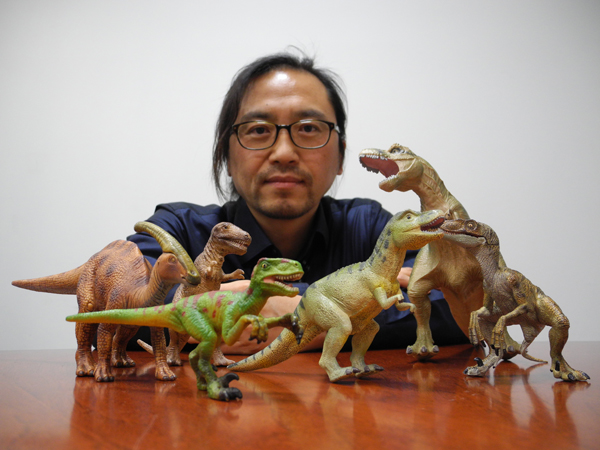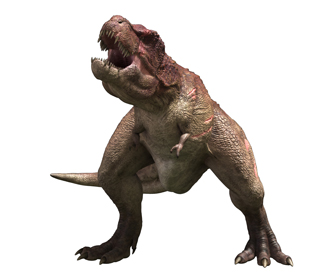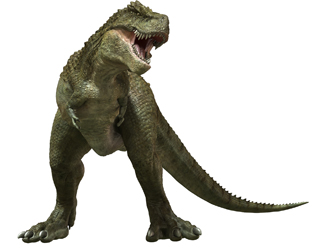Back from near extinction, dinosaurs tromp through new film

Dinosaurs once roamed through Korean film, but none were very fierce. All of the reptiles were shoddy creatures shot with miniature action figures, resulting in unnatural performances and awkward movements. The lack of technology also allowed these gigantic characters just one facial expression: an angry face with a mouth wide open to reveal a set of threatening, peg-like teeth.

Now, in a bid to revive the genre, “Speckles the Tarbosaurus” is aiming to bring back a dinosaur of film with a 3-D twist.
The film brings about 17 different types of dinosaurs to life with picture-perfect graphics and panoramic scenes of the New Zealand landscape, where many scenes were shot. With the computer graphic-laden but realistic dinosaurs on screen, every scene is beautifully created with a combination of real and computer-generated images.

The response to the film has been explosive. Released on Jan. 26, the film topped box office sales in its first week, pushing aside star-studded foreign and domestic films. In the second week of its release, the film has thus far attracted more than 300,000 viewers and still holds the No. 3 spot in terms of box office sales.
The film is directed by Han Sang-ho and although this is his first feature film outing, Han, who works full time at EBS, is a longtime producer of documentary films and previously made a documentary about the dinosaurs of the Korean Peninsula three years ago. The documentary is still regarded as the most popular in the broadcaster’s history and provided Han with the inspiration for the film.
The Korea JoongAng Daily caught up with Han earlier this week and talked with him about the film. Here are excerpts from the interview.
Q. Production on the film was delayed for about a year and it took three years for you to complete it. What was your biggest challenge during that time?
A. The longer it takes to produce a film, the more you spend and the production costs mounted throughout. In addition to that, I was responsible for overseeing about 500 people who worked on the film. The extreme stress I was under even made me sick. I lost about 8 kilograms [17.6 pounds] and my left eardrum split two years ago for what seemed like no reason, but maybe it was because of stress.
What took you so long? You had made a documentary about dinosaurs in Korea in 2008.
It was January 2009 when I decided to make this film in 3-D. I just thought it would be fun, even though Korea was at a very early stage in terms of 3-D production techniques. It was even difficult to find 3-D cameras back then. As I was struggling with this, I met cinematographer Kim Byung-il, who is famous for [2002’s] “Sympathy for Mr. Vengeance.” He was one of a handful of successful cinematographers and was crazy about 3-D films. He’d put aside his full-time job and was developing 3-D filmmaking tools at his own expense. We shot a couple of scenes in a trial run with a camera Kim made that was about 2 meters [6 foot 6 inches] tall and weighed about 100 kilograms, but we eventually gave up. We went through a lot of trial and error. And then “Avatar” was released later that year in December. I didn’t want to disappoint Koreans [who had already seen “Avatar” and had high expectations for 3-D films].
How was it possible to recruit 500 people for this film when nobody actually had experience with 3-D production techniques?
It was hard. Tools for 3-D filmmaking were released one after another but there weren’t that many people who could handle the equipment. So we taught them. Once we started, it took about two years to achieve decent 3-D images. We spent about 8 billion won [$7.15 million] on the film, but that’s quite a small sum compared to what major Hollywood studios spend. Take the 3-D version of “Titanic,” it cost about 100 million won to convert a minute of original film into 3-D.
The popularity of your film got me thinking about why we haven’t had any dinosaur films for so many years. What do you think?
It’s all about technology. Making a dinosaur film requires complex technology. You need to know how to do animation, how to work with computer graphics and how to synthesize many different layers of images. We were able to reduce our expenses because the people who worked on the film were flexible and had a broad range of skills.
Most people have very fixed ideas about dinosaurs but your characters, especially little Jumbagi, are quite stunning because they look real but are also really cute. How did you achieve this?
We had fierce, marathon discussions for about a year while creating Jumbagi. We wanted the character to look like a real dinosaur but it also had to look cute with a baby face. The size of its eyes was also an issue. If the eyes were too big, it started looking like animation.
You’ve worked as a producer of documentaries for 17 years. Did that help you when you were working on this film?
This is a fictional film but I wanted to create a story based on facts. As I was doing research on dinosaurs, I found a paper about nine dinosaur fossils found in Canada and it inspired me. The paper said that scientists saw the nine dinosaurs as one family. As in my film, each family member had a different role when they went out hunting. And because I wanted to reproduce the environment where the dinosaurs used to live, I did a lot of research. The whole process was easier because I’m a documentary producer.
Do you plan to make a sequel to “Speckles the Tarbosaurus”?
It depends on the success of the film, but I’d like to see more of Jumbagi on screen in the future.
By Sung So-young [so@joongang.co.kr]










with the Korea JoongAng Daily
To write comments, please log in to one of the accounts.
Standards Board Policy (0/250자)